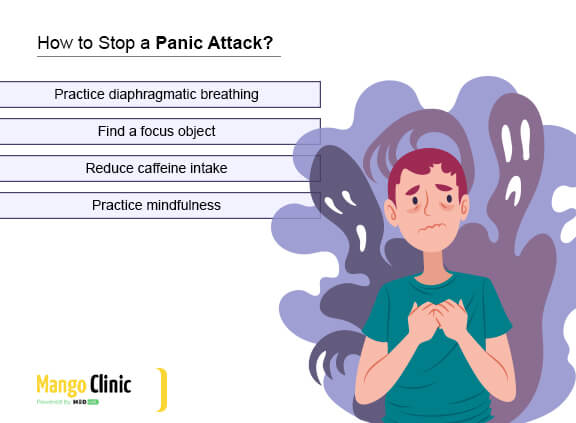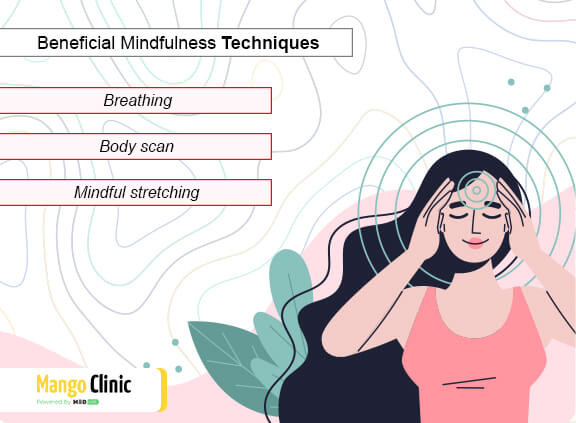How to Stop a Panic Attack? 7 Effective Techniques

A panic attack can be a terrifying experience, especially if someone doesn’t know how to stop panic attacks. They can occur when you are alone or in public, in the daytime or at night. A panic attack often happens as a response to triggers or for no apparent reason and also might be a sign of stress or PTSD. It lasts from 5 to 20 minutes and comes with unpleasant symptoms. These may include fast breath (because the body tries to absorb more oxygen), increased heartbeat, shaking, sweating, sense of impending danger, and muscle strain, among others.
Although panic attacks may feel intense and scary, they aren’t life-threatening. Still, to feel more confident about such situations, it is beneficial to learn several coping mechanisms for panic attacks and the ways to reduce the probability of their occurrence.
Tired of having sudden panic attacks? Our doctors at Mango Clinic are ready to help!
Take Deep Breaths
Breathing is a natural practice every human does effortlessly, but not everyone knows it is one of the best ways to control panic attacks. One helpful technique is called diaphragmatic breathing. It requires one to put their attention and efforts into the breathing process. While it may seem simple, it can make a big difference when done routinely or as an immediate action when the anxiety attack starts. It can be practiced for about 5 minutes and includes the next steps:
- Get a comfortable position: lie on the floor or be seated, leaning against the back of the seat.
- Put one hand on your chest and put the other one on your stomach.
- Inhale through the nose and exhale slowly through pursed lips.
- As you breathe, the hand on your belly should move more than the one on the chest.
- Repeat the process.
Even though it might be challenging to follow this technique at first, it would help to handle panic attacks when they are coming, and it will affect your mind and body positively.
Find a Focus Object
A focus object can be anything. However, it should be small enough to carry around: squishy balls, a pen, or something you find soothing. This method aids one to calm down from a panic attack as it aims to divert a person’s attention from the symptom and redirect it toward the object. A quick switch to examining the object’s details and colors shifts the mind from anxious thoughts to the item. In turn, their anxiety decreases.
Avoid Negative Thoughts
People’s thoughts can determine how they view themselves and the world around them. Any thought grounded in pessimism can negatively impact their emotions and overall mental health. These harmful perceptions can elevate a person’s worry or fear. However, cognitive distortions can be overcome over time by the following self-help techniques that may serve as an addition to traditional panic attack treatment:
- Exercise. It helps relieve inner tension.
- Talk it over. It helps by reassessing negative thoughts in a more affirmative light.
- Replace negativity in your surroundings with positivity.

Reduce Caffeine Intake
Studies show that taking high doses of caffeine can lead to caffeine-induced panic attacks. Those with anxiety disorders may find their panic attack symptoms more frequent when taking a caffeinated drink. However, cutting back on caffeine can significantly reduce intense bouts of panic attacks.
Try CBT and other types of psychotherapy at Mango Clinic to cope with the symptoms of panic attacks and learn how to prevent them better.
Get Enough Exercise
Engaging in exercise is one of the tips for anxiety attack prevention as it helps one divert from tense situations. According to some studies (Felipe B. Schuch PhD, Brendon Stubbs PhD), people with panic disorders who engage in high-level physical activities are less likely to develop panic attack symptoms than those with sedentary lifestyles. Moving around enables the body to release endorphins that help relax the body. Exercises can range from walking to uphill cycling or other high-intensity activities.
Practice Meditation
While panic attacks cause the fight or flight response, meditation triggers the body’s relaxation response. Therefore, it is a powerful tool for lessening panic attack symptoms. Although the effects of meditation on panic attacks cannot be instant, a committed meditation practice can help wind down future panic attacks with a higher probability. Here are some meditation techniques you can try:
- Walking meditation
- Breathing meditation
- Five senses meditation
- Guided meditation
Worth noting that there is no perfect or wrong way to meditate. Also, each meditation technique has risks and benefits; therefore, it might not work for everyone.

Practice Mindfulness
If you want to deal with anxiety attacks in the long run, consider trying mindfulness. This technique can ease panic attacks by helping you to be more aware of the present moment. It involves paying attention to who you are with, your thoughts, feelings, and senses, and returning your attention to the present moment whenever your mind wanders. Even though mindfulness is a skill that can help to prevent or ease panic attacks, it can also be used during the incident to lessen the symptoms.
In its emphasis on focusing on the present moment, this method can be self-directed or guided. Although it’s relatively simple and easy to master, beginners are recommended to set aside a specific time to practice mindfulness daily and use guided mindfulness sessions. These are some of the most common types to try:
- Breathing. Mindful breathing entails getting a quiet place. While seated, focus on breathing in deeply for three seconds and slowly breathing out for another three seconds. You can repeat the process until you are in control of your thoughts.
- Mindful stretching. For this practice, focus on breathing while in the stretch. Think about how your body feels and avoid distracting thoughts.
- Body scan. During this exercise, maintain an upright spine and close your eyes. At the same time, observe how your body breathes in and out and pay attention to your body’s sensations. Also, acknowledge any tension and attempt to release it by relaxing that part of your body.
The practice should last anywhere from 20 to 40 minutes.
Summing Up
People of all ages can experience panic attacks. While there is no magic cure, knowing how to stop a panic attack can help shorten such episodes or make them less severe. And although such intense feelings can be frightening, proactivity can help lessen them. Choose any of the techniques mentioned above and be consistent with them until you notice that you can effectively manage your panic attacks. And if your anxiety attacks remain frequent or become overwhelming, consider seeing a doctor and getting appropriate treatment at Mango Clinic.









